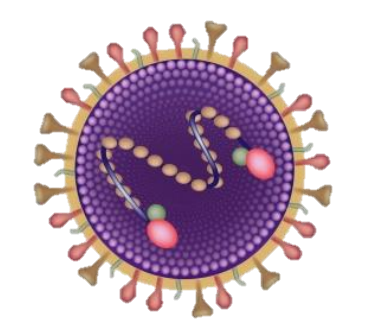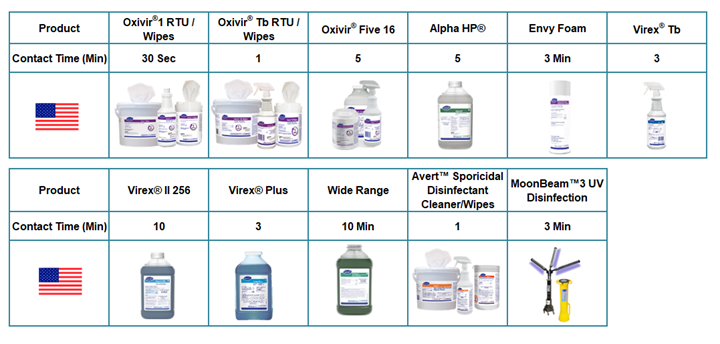
General Information
Respiratory syncytial (sin-SISH-uhl) virus (RSV) is a member of the genus Pneumovirus, in the family Paramyxoviridae. The virus is an enveloped virus that is 150-300 nm in diameter. The virus infects the lungs and breathing passages. RSV can cause upper respiratory infections (such as colds) and lower respiratory tract infections (such as bronchiolitis and pneumonia). Healthy people who are infected usually experience mild, cold-like symptoms, but it can cause serious infections in infants and older adults. It is the major cause of respiratory tract infections and hospitalization during infancy and early childhood.
Significance
In children younger than one year of age, RSV is the most common cause of bronchiolitis, an inflammation of the small airways in the lung, and pneumonia, an infection of the lungs. Almost all children will have had an RSV infection by their second birthday. When infants and children are exposed to RSV for the first time:
- 25 – 40% have signs or symptoms of bronchiolitis or pneumonia
- 5 to 20 out of 1,000 will require hospitalization. Most children hospitalized for RSV infection are younger than 6 months of age.
Premature infants, children younger than 2 years of age with congenital heart or chronic lung disease, and children with compromised (weakened) immune systems due to a medical condition, or medical treatment are at highest risk for severe disease. Adults with compromised immune systems and those 65 and older are also at increased risk of severe disease. Outbreaks of RSV have been reported in long term facilities which caused complete closure of these facilities.
People of any age can get an RSV infection, but the severity of infections in older adults is higher. Each year, it is estimated that more than 177,000 older adults are hospitalized and 14,000 of them die in the United States due to RSV infection. It has been found to cause one third of lower respiratory tract infections in the elderly population. Those at higher risk include adults over 65 years of age, Adults with chronic heart or lung disease or those with weakened immune systems.
Symptoms
Symptoms of RSV infection are similar to other respiratory infections. Illness usually begins 4 to 6 days after exposure with a runny nose and decrease in appetite (ranging from 2 to 8 days). Coughing, sneezing and fever typically develop 1 to 3 days later, wheezing may also occur.
In very young infants, irritability, decreased activity, loss of appetite and breathing difficulties may be the only symptoms of infection. Healthy infants infected with RSV do not need to be hospitalized. In most cases, even among those who need to be hospitalized, hospitalization usually lasts for only a few days, and full recovery from illness occurs in about 1 to 2 weeks. However, even after recovery, very young infants and children with weakened immune systems can continue to spread the virus for 1 to 3 weeks.
Adults may have RSV but presents similar to the common cold. In older adults there is not a distinguished clinical presentation, i.e., older adults may not have a fever. When an older adult presents symptoms, influenza is frequently the first tentative diagnosis and other health issues such as Chronic Obstructive Pulmonary Disease (COPD), a suppressed immune system that may lead to pneumonia.
Transmission
People infected with RSV are usually contagious for 3 to 8 days. However, some infants and people with weakened immune systems can be contagious for as long as 4 weeks. Children are often exposed to and infected with RSV outside the home, such as school or childcare. They can then transmit the virus to other members of the family. RSV typically lives on soft surfaces such as tissues and hands for shorter amounts of time.
RSV can be spread when an infected person coughs or sneezes into the air, creating virus-containing droplets that can linger briefly in the air. Other people can become infected if the droplet particles contact their nose, mouth, or eye. RSV can survive for many hours on surfaces.
Infection can also result from direct and indirect contact with nasal or oral secretions from infected people. Direct contact with the virus can occur, for example, by kissing the face of a child with RSV. Indirect contact can occur if the virus gets on an environmental surface, such as a doorknob or other surfaces that are then touched by other people. Direct and indirect transmissions of virus usually occur when people touch an infectious secretion and then rub their eyes, nose or mouth. Thorough hand hygiene is recommended after coming in contact with secretions, or touching a potentially contaminated environment.
Treatment
There is no specific treatment for RSV infection. The typical treatment includes fever-reducing and pain medications such as ibuprofen and acetaminophen. For young children, consultation with your physician is necessary prior to administering over-the-counter medication. Hydration is important. Children and adults with severe symptoms should see a physician and if indicated medication and/or breathing treatments may be prescribed.
Prevention
Researchers are continuing to work on RSV vaccine development, but none is available yet. However, steps that can be taken to help prevent the spread of RSV. Specifically, people who have cold-like symptoms should:
- Cover your mouth or try to cover the mouth of a child when they cough and sneeze
- Keep your hands away from your face (eyes, nose, mouth also known as the T – zone)
- Wash their hands frequently and correctly (with soap and water for 20 seconds) or sanitize hands using alcohol-based hand sanitizers.
- Avoid close contact with sick individuals, sharing their cups and eating utensils and kissing.
- Wash your hands often
- Clean and disinfect commonly touched surfaces which may be contaminated.
- Stay home if you are sick.
Parents should pay special attention to protecting children at high risk for developing severe disease if infected with RSV. Such children include premature infants, children younger than 2 years of age with chronic lung or heart conditions, and children with weakened immune systems.
Cleaning and Disinfection
Frequent cleaning and disinfection of environmental services is a key component in a comprehensive “respiratory illness” prevention strategy.
The following are Diversey disinfectants effective against RSV, an enveloped virus:

References
1. cdc.gov/rsv/index.html

